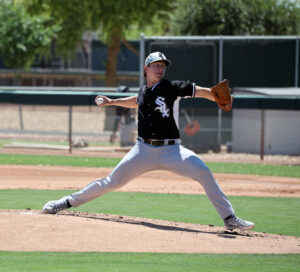Prospect Focus – Michael Kopech, with video and quotes
Late last week, I sat among the scouts to take in a Michael Kopech start. It ended up being his shortest outing of the year, lasting just three full innings, allowing four earned runs. He walked as many batters as he struck out (3), and threw a wild pitch.
He also had some of his best stuff of the season.
Kopech is the top pitching prospect in the White Sox system and is among the top pitching prospects in all of baseball, which leads you to expect regular dominance. But this particular start was a great example of why stat line scouting, especially from game to game, can lead to some incorrect assumptions. I’ll illustrate, with the aid of some video, and quotes from Michael and his pitching coach, Jose Bautista.
Kopech is a physical specimen with a frame and build that could serve as a mold for a build-your-own pitcher kit. He shows excellent athleticism defensively from the mound, and in his delivery. Scouting reports are easy to find (people like writing about guys like Michael), and they speak of an already-plus fastball and slider, developing change-up and more to gush about.
Context is king when evaluating prospects, so let’s start with this: it was a rainy evening in Birmingham on June 29th, with precipitation falling throughout the contest to varying degrees. The first casualty of the weather was one of Kopech’s pitches, as he told me the next day that, “I couldn’t grip my change-up because it was raining, but at the time I didn’t need the change-up.” He felt his stuff was plenty to work with even without the change.
In his first inning of work, Kopech was leaning heavily on his four-seam fastball, at 96 to 97 mph and touching 98 once. He appeared to be using both sides of the plate, if not with utter precision then at least in the right area. His slider made a couple cameo appearances, running 87 and 88 and showing the substantial, late two-plane break that had scouts raving.
Michael’s delivery isn’t terribly high effort for a guy that throws this kind of heat. Though he does cross over from a closed plant, and he shows a big arm recoil at the end. In that first inning, he was consistent with that delivery and looked very comfortable with it. It was effective enough that he got out of the inning on a crisp 11 pitches, and no hard contact allowed.
Things started to falter a bit in his second inning of work, but not right away. Here’s a 4-pitch sequence against Michael Choice, as the inning opened and he was still pretty locked in. He goes fastball inner half at 97, buried slider, slider off the plate, and finishes the strikeout with 97 inside:
After whiffing Choice, Blake Allemand sliced a double down the 3B line on what was actually a good pitch, 96 and just outside the zone. It wasn’t hit very hard either, but found the hole in the infield:
After that, he threw a wild pitch and walked the next batter. When Kopech is working from the wind-up, he works quickly. But when in the stretch, he slows the whole pre-delivery process considerably. It seems as though this may cause him to get out of rhythm a bit.
A sacrifice fly scores a run, but another strikeout ends the frame with just one run crossing the plate.
Now into the third inning, and this is where things disintegrated. He walked Wendell Rijo to open the frame, and that was one of the at-bats where it was clear he couldn’t command his change of pace. After a bunt pop-out, there was another sliced flare for a hit by Angel Ortega:
And then a grounder that went of Kopech’s glove for another “hit”. And this ducksnort that glanced off Jake Peter‘s glove:
At this point, his body language started to change. The frustration manifested outwardly, as he paced around the mound between at-bats, and looked more hunched over when he got on the rubber. This seemed to carry over into his actual pitching, as his release point and other mechanical factors started varying from pitch to pitch – you start to see it in the last video above. As noted earlier, he worked slowly from the stretch, which further got him off rhythm.
This and the body language seem to be simple maturity issues – this is a 21-year old in AA, and it’s not uncommon. But it is worth noting as an area for development.
He finished the third inning with a ground-out, at 71 pitches. Of the five hits he allowed, not a one of them qualified as hard contact – we’ll let Jose Bautista describe what there was a lot of:
It happens, when a guy throws that hard, the hitters will have blooper hits, ground balls, a lot of what we call bullshit. But he knows he didn’t pitch that bad.
So in the end, while the on-field results were pretty poor, this elite pitching prospect still showed his elite stuff. Here’s what I had from my notes on the individual pitches:
- Four-seam fastball used heavily, ran usually 96-98 but touched 100 and 99 once each. Location less than surgical but effective from the wind-up, diminishes from the stretch. Fades in to righties.
- Two-seam fastball used much less often, 94-95 typically, showed well with some cut action.
- Slider was 86-88, usually showed that good, late movement, and he delivered it without giving it away. Location seemed to go to plan most of the time.
- Change-up is a work in progress ranging from 85 to 89, has some tumble but he wasn’t able to command it.
While there is some refinement that can be done on his pitches, most of the development needs I can see are on the mental side of the game. This is a pitcher who, this year, is really getting his first taste of occasional on-field failure. How effective he is in learning to keep a more even keel, and taking this kind of start in stride both during and after, will be key for his development. Still quite young for the league, here’s Michael’s overall take on the start:
In my opinion – and I told [Pitching Coach Jose] Bautista this the other day – in my opinion, that’s the best stuff I’ve had all year… That’s the best my two-seam has looked all year, best I’ve stayed at the bottom of the zone. My slider was there, really everything was the best I’ve had all year. Just five little bloop hits, cheap hits, got pieced together. Even one off my glove, one was a broken bat that went flying, there was just those five cheap hits that kind of took over my whole outing. And that was out of my control. It was very frustrating, but I have to look at it as, what can I control? I felt like I did what I could to compete, with what was going on, and it just wasn’t enough that day.
As a complete package, Michael Kopech certainly belongs among the elite prospects across baseball. The fastball combo is plus, his slider often shows plus, the change-up is developing, and he oozes athleticism. Yes, he has some maturing to do, and he himself will tell you his change-up needs work. He won’t be in Chicago this year. But don’t let an ugly box score like this one lead you to believe he’s anything other than one of the most talented pitchers currently in minor league baseball.
Want to know right away when we publish a new article? Type your email address in the box on the right-side bar (or at the bottom, if on a mobile device) and click the “create subscription” button. Our list is completely spam free, and you can opt out at any time.






